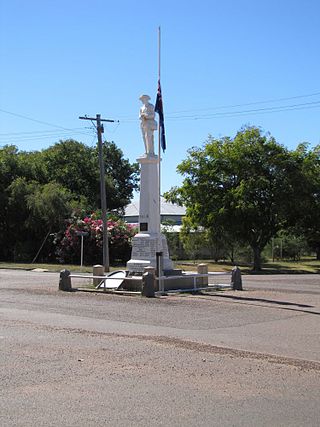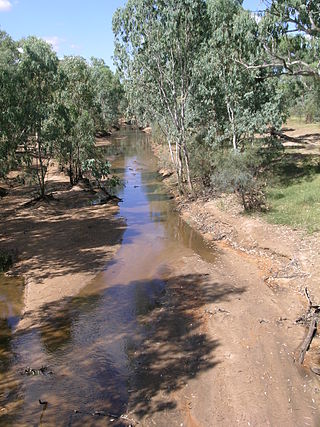
Longreach is a town and a locality in the Longreach Region, Queensland, Australia. It is the administrative centre of the Longreach Regional Council, which was established in 2008 as a merger of the former Longreach, Ilfracombe, and Isisford shires. Longreach is a well known tourist destination due to its aviation history and importance. In the 2021 census, the locality of Longreach had a population of 3,124.

Aramac is a rural town and locality in the Barcaldine Region, Queensland, Australia. In the 2021 census, the locality of Aramac had a population of 372 people.

Muttaburra is an outback town and locality in the Barcaldine Region, Queensland, Australia. Muttaburra was the discovery site of the Muttaburrasaurus, one of Australia's most famous dinosaurs.

The Barcaldine Region is a local government area in Central West Queensland, Australia. Established in 2008, it was preceded by three previous local government areas which had existed for over a century.

The Alice River in central Queensland, Australia rises on the western slopes of the Great Dividing Range. The river bisects the Shire of Barcaldine, flowing in a south-westerly direction towards Isisford and its confluence with the Barcoo River. The town of Barcaldine is located on the Alice River. The Alice River's tributaries include Jordan Creek and Lagoon Creek. The Alice River is often dry, except after the annual summer rains.
Wanggamala, also spelt Wanggamanha, Wangkamahdla, Wangkamadla, Wangkamanha, Wangkamana, Wonkamala, Wongkamala, Wonkamudla, and other variants, is an extinct Australian Aboriginal language of the Pama–Nyungan family, previously spoken in the Northern Territory around Hay River and to the south of the Andegerebinha-speaking area.

Bowen Downs Station is a pastoral lease that has operated both as a cattle station and a sheep station.

Cornish Creek is a former rural locality in the Barcaldine Region, Queensland, Australia. In the 2016 census, Cornish Creek had a population of 16 people.
The Barungguan are an Aboriginal Australian people of the Cape York Peninsula of Northern Queensland. The name is associated with three languages: Ganganda, Umpithamu and Morrobolam.
The Wangan are an Aboriginal Australian people of the Isaac Region of Central Queensland.
The Wirdinja were an Aboriginal Australian people of the Pilbara region of Western Australia.
Yadaneru, also written Jeteneru, refers to a tribe at one time thought to have existed in the Cape York Peninsula of northern Queensland.
The Laia were an Aboriginal Australian people of the state of Queensland.
The Ewamian or Agwamin people are an Aboriginal Australian people of the state of Queensland.
The Yilba, also written Ilba and Jilba, are or were an Aboriginal Australian people of the present-day state of Queensland.
The Yanga people, also spelt Jangaa, Janggal, Janga, and Yangaa, are an Aboriginal Australian people of the state of Queensland. They may be the same as the Yukulta / Ganggalida / Nyangga group. They are not to be confused with the Yangga.
The Yagalingu are an Aboriginal Australian people of the state of Queensland. Their language may have been a dialect of Bidjara.
The Kungadutji were an indigenous Australian people of the state of Queensland.
The Madjandji, also known as the Majañji, are indigenous Australian people in the area south of Cairns in the state of Queensland.
The Kongabula were an indigenous Australian people of the state of Queensland.